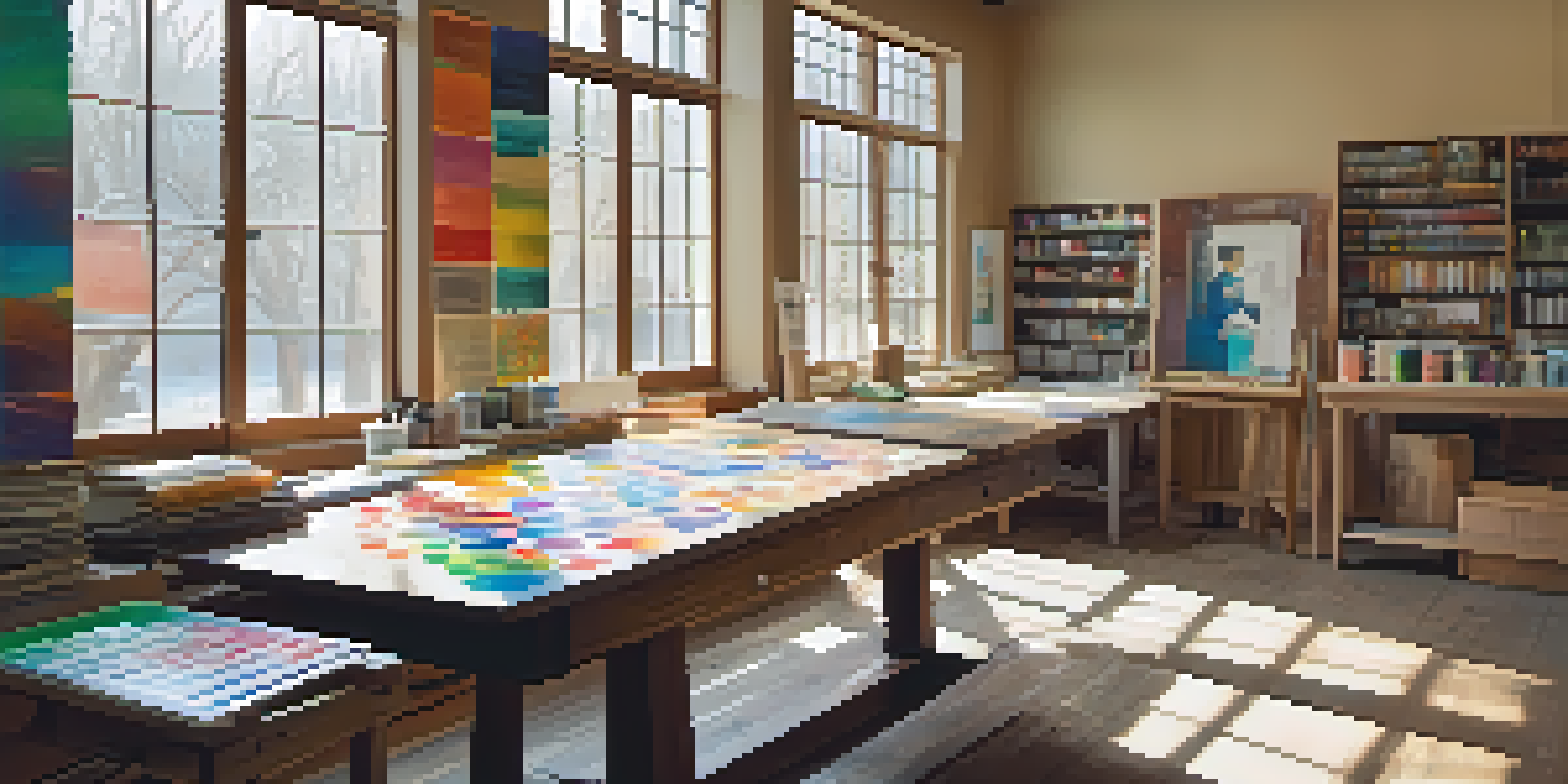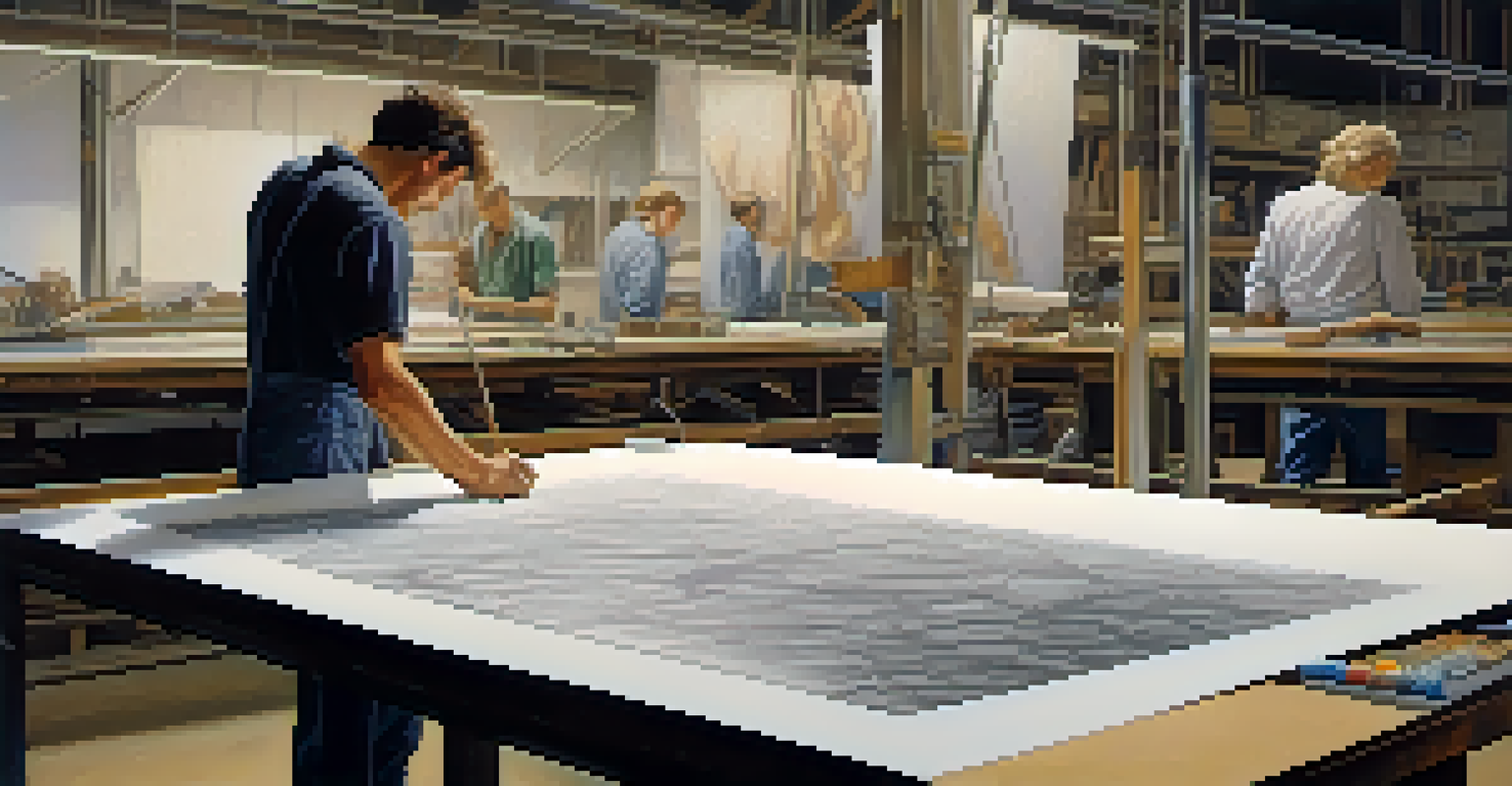The Art of Printmaking: Techniques for Beginners and Experts

Understanding the Basics of Printmaking
Printmaking is a fascinating art form that involves creating artworks by transferring ink from a matrix onto a surface. This could be paper, fabric, or even wood. The beauty of printmaking lies in its variety; it encompasses techniques like relief, intaglio, lithography, and screen printing, each offering unique effects and styles.
Every artist was first an amateur.
For beginners, grasping the fundamentals is crucial. You don’t need an art degree to start; understanding the tools and materials is enough to get your creative juices flowing. Begin with simple projects to familiarize yourself with the process – after all, practice is the key to mastering any art form.
As you gain confidence, you can experiment with different techniques and expand your repertoire. Remember, printmaking is as much about the process as it is about the final product, so embrace the learning journey!
Essential Tools and Materials for Printmaking
To kickstart your printmaking adventure, gathering the right tools and materials is essential. Basic supplies include a brayer (roller), ink, a printing plate, and high-quality paper. Each tool plays a specific role in the printmaking process, so understanding their functions can significantly enhance your artwork.

For example, a brayer helps evenly distribute ink on your plate, while different types of plates – like linoleum or wood – can produce varied textures and depths. Beginners might start with inexpensive materials, but as you advance, investing in quality supplies can elevate your prints.
Printmaking Techniques for Beginners
Printmaking offers various techniques like relief, intaglio, and screen printing, allowing beginners to explore their creativity in different ways.
Don’t forget to include a clean workspace! A dedicated area for printmaking will help you stay organized and focused, allowing your creativity to flourish without interruption.
Relief Printing: A Beginner-Friendly Technique
Relief printing is one of the most accessible printmaking methods for beginners. In this technique, you carve an image into a soft material, such as linoleum or wood, and apply ink to the raised surfaces. When pressed onto paper, the ink transfers, creating a striking image.
Art is the most beautiful of all lies.
This technique allows for a hands-on approach to creativity. You can experiment with different carving tools to achieve various textures and details. Plus, the process is forgiving; if you make a mistake, you can always carve a new design or adjust your technique.
As you get comfortable with relief printing, consider incorporating multiple colors by using separate blocks for each hue. This adds depth and vibrancy to your prints, making them truly unique.
Exploring Intaglio: More Complex Techniques
Intaglio is a printmaking technique that offers a different approach compared to relief printing. Instead of carving away from a surface, you create images by incising lines into a metal plate. The ink is then applied and wiped off, leaving ink only in the incised areas for printing.
Although intaglio can seem intricate and daunting, it opens up a world of possibilities for detailed and precise artworks. Techniques within intaglio, such as etching and engraving, allow for fine lines and intricate designs, perfect for those looking to explore their artistic skills further.
Essential Tools for Printmaking
Gathering the right tools, such as brayers and printing plates, is crucial for enhancing your printmaking experience and artwork quality.
While this method requires more equipment and practice, the results can be stunning. Embrace the challenge, and you may find that intaglio becomes your favorite way to express your artistic vision.
Lithography: Drawing with Ink on Stone
Lithography is a unique printmaking technique that involves drawing directly onto a flat surface, traditionally limestone or metal. The artist uses a greasy medium to create an image, which is then treated with a chemical process that allows for ink to adhere only to the drawn areas.
This method is celebrated for its ability to capture fine details and subtle gradients, making it ideal for artists who enjoy drawing. As a beginner, you might find lithography a refreshing change from traditional carving techniques, allowing for spontaneous creativity.
Although lithography requires some specialized materials and knowledge of the chemical processes involved, the results can be incredibly rewarding. It’s a beautiful way to merge drawing and printmaking, giving your artwork a distinct character.
Screen Printing: Versatile and Fun for All Levels
Screen printing, or serigraphy, is another popular technique that appeals to both beginners and seasoned artists. This method involves creating a stencil on a mesh screen and using a squeegee to push ink through the screen onto your chosen material. The results are vibrant and bold, making it perfect for graphic designs and textiles.
One of the great things about screen printing is its versatility; you can print on various surfaces, including paper, fabric, and even wood. This opens up endless possibilities for creative projects, from T-shirts to posters.
Join the Printmaking Community
Connecting with local and online printmaking communities can provide inspiration, support, and valuable learning opportunities.
For beginners, there are many DIY screen printing kits available, making it easier than ever to start experimenting. As you gain experience, you can explore more complex techniques, including multi-color prints and layering.
Caring for Your Printmaking Tools and Workspace
Once you've dived into the world of printmaking, it's essential to take care of your tools and workspace. Proper maintenance can prolong the life of your materials and ensure the best results in your prints. Cleaning your tools after each use prevents ink buildup and keeps everything in working order.
Additionally, organizing your workspace can significantly enhance your creative process. Keep your inks, papers, and tools within reach but neatly arranged. This way, you can focus on creating rather than searching for supplies.

Investing a little time in upkeep not only maintains your tools but also fosters a more inviting and productive environment. A clean and organized space can inspire creativity and help you stay motivated.
Finding Inspiration: Joining the Printmaking Community
As you explore printmaking, connecting with a community can be incredibly inspiring. Joining local art groups or attending workshops can provide valuable insights and encouragement. You'll find that sharing experiences and techniques with fellow artists can spark new ideas and enhance your skills.
Online platforms also offer a wealth of resources, including tutorials, forums, and social media groups dedicated to printmaking. Engaging with others who share your passion can help you stay motivated and discover fresh approaches.
Remember, art is not just about the final piece; it's also about the relationships you build along the way. Embrace the community aspect of printmaking, and you'll find endless inspiration to fuel your creative journey.